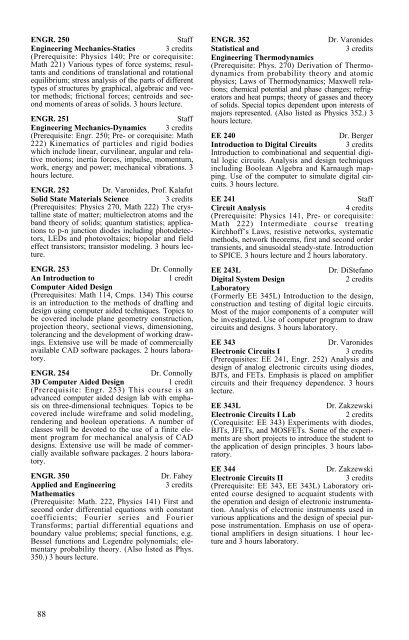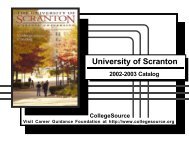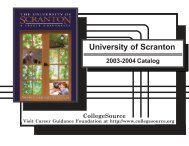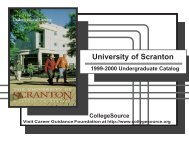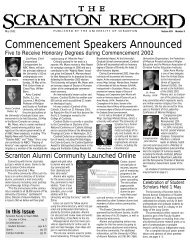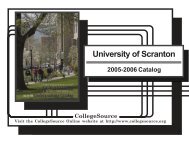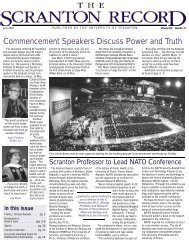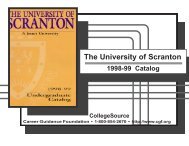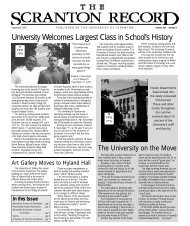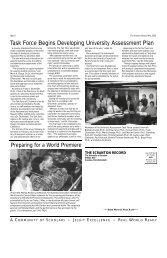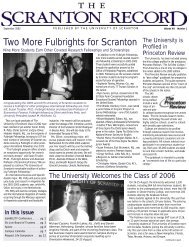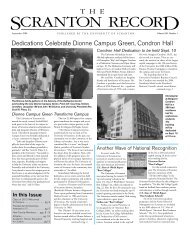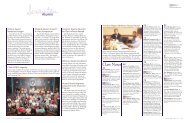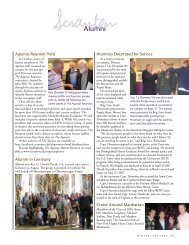You also want an ePaper? Increase the reach of your titles
YUMPU automatically turns print PDFs into web optimized ePapers that Google loves.
ENGR. 250 Staff<br />
Engineering Mechanics-Statics 3 credits<br />
(Prerequisite: Physics 140; Pre or corequisite:<br />
Math 221) Various types <strong>of</strong> force systems; resultants<br />
and conditions <strong>of</strong> translational and rotational<br />
equilibrium; stress analysis <strong>of</strong> the parts <strong>of</strong> different<br />
types <strong>of</strong> structures by graphical, algebraic and vector<br />
methods; frictional forces; centroids and second<br />
moments <strong>of</strong> areas <strong>of</strong> solids. 3 hours lecture.<br />
ENGR. 251 Staff<br />
Engineering Mechanics-Dynamics 3 credits<br />
(Prerequisite: Engr. 250; Pre- or corequisite: Math<br />
222) Kinematics <strong>of</strong> particles and rigid bodies<br />
which include linear, curvilinear, angular and relative<br />
motions; inertia forces, impulse, momentum,<br />
work, energy and power; mechanical vibrations. 3<br />
hours lecture.<br />
ENGR. 252 Dr. Varonides, Pr<strong>of</strong>. Kalafut<br />
Solid State Materials Science 3 credits<br />
(Prerequisites: Physics 270, Math 222) <strong>The</strong> crystalline<br />
state <strong>of</strong> matter; multielectron atoms and the<br />
band theory <strong>of</strong> solids; quantum statistics; applications<br />
to p-n junction diodes including photodetectors,<br />
LEDs and photovoltaics; biopolar and field<br />
effect transistors; transistor modeling. 3 hours lecture.<br />
ENGR. 253 Dr. Connolly<br />
An Introduction to 1 credit<br />
Computer Aided Design<br />
(Prerequisites: Math 114, Cmps. 134) This course<br />
is an introduction to the methods <strong>of</strong> drafting and<br />
design using computer aided techniques. Topics to<br />
be covered include plane geometry construction,<br />
projection theory, sectional views, dimensioning,<br />
tolerancing and the development <strong>of</strong> working drawings.<br />
Extensive use will be made <strong>of</strong> commercially<br />
available CAD s<strong>of</strong>tware packages. 2 hours laboratory.<br />
ENGR. 254 Dr. Connolly<br />
3D Computer Aided Design 1 credit<br />
(Prerequisite: Engr. 253) This course is an<br />
advanced computer aided design lab with emphasis<br />
on three-dimensional techniques. Topics to be<br />
covered include wireframe and solid modeling,<br />
rendering and boolean operations. A number <strong>of</strong><br />
classes will be devoted to the use <strong>of</strong> a finite element<br />
program for mechanical analysis <strong>of</strong> CAD<br />
designs. Extensive use will be made <strong>of</strong> commercially<br />
available s<strong>of</strong>tware packages. 2 hours laboratory.<br />
ENGR. 350 Dr. Fahey<br />
Applied and Engineering 3 credits<br />
Mathematics<br />
(Prerequisite: Math. 222, Physics 141) First and<br />
second order differential equations with constant<br />
coefficients; Fourier series and Fourier<br />
Transforms; partial differential equations and<br />
boundary value problems; special functions, e.g.<br />
Bessel functions and Legendre polynomials; elementary<br />
probability theory. (Also listed as Phys.<br />
350.) 3 hours lecture.<br />
88<br />
ENGR. 352 Dr. Varonides<br />
Statistical and 3 credits<br />
Engineering <strong>The</strong>rmodynamics<br />
(Prerequisite: Phys. 270) Derivation <strong>of</strong> <strong>The</strong>rmodynamics<br />
from probability theory and atomic<br />
physics; Laws <strong>of</strong> <strong>The</strong>rmodynamics; Maxwell relations;<br />
chemical potential and phase changes; refrigerators<br />
and heat pumps; theory <strong>of</strong> gasses and theory<br />
<strong>of</strong> solids. Special topics dependent upon interests <strong>of</strong><br />
majors represented. (Also listed as Physics 352.) 3<br />
hours lecture.<br />
EE 240 Dr. Berger<br />
Introduction to Digital Circuits 3 credits<br />
Introduction to combinational and sequential digital<br />
logic circuits. Analysis and design techniques<br />
including Boolean Algebra and Karnaugh mapping.<br />
Use <strong>of</strong> the computer to simulate digital circuits.<br />
3 hours lecture.<br />
EE 241 Staff<br />
Circuit Analysis 4 credits<br />
(Prerequisite: Physics 141, Pre- or corequisite:<br />
Math 222) Intermediate course treating<br />
Kirchh<strong>of</strong>f’s Laws, resistive networks, systematic<br />
methods, network theorems, first and second order<br />
transients, and sinusoidal steady-state. Introduction<br />
to SPICE. 3 hours lecture and 2 hours laboratory.<br />
EE 243L Dr. DiStefano<br />
Digital System Design 2 credits<br />
Laboratory<br />
(Formerly EE 345L) Introduction to the design,<br />
construction and testing <strong>of</strong> digital logic circuits.<br />
Most <strong>of</strong> the major components <strong>of</strong> a computer will<br />
be investigated. Use <strong>of</strong> computer program to draw<br />
circuits and designs. 3 hours laboratory.<br />
EE 343 Dr. Varonides<br />
Electronic Circuits I 3 credits<br />
(Prerequisites: EE 241, Engr. 252) Analysis and<br />
design <strong>of</strong> analog electronic circuits using diodes,<br />
BJTs, and FETs. Emphasis is placed on amplifier<br />
circuits and their frequency dependence. 3 hours<br />
lecture.<br />
EE 343L Dr. Zakzewski<br />
Electronic Circuits I Lab 2 credits<br />
(Corequisite: EE 343) Experiments with diodes,<br />
BJTs, JFETs, and MOSFETs. Some <strong>of</strong> the experiments<br />
are short projects to introduce the student to<br />
the application <strong>of</strong> design principles. 3 hours laboratory.<br />
EE 344 Dr. Zakzewski<br />
Electronic Circuits II 3 credits<br />
(Prerequisite: EE 343, EE 343L) Laboratory oriented<br />
course designed to acquaint students with<br />
the operation and design <strong>of</strong> electronic instrumentation.<br />
Analysis <strong>of</strong> electronic instruments used in<br />
various applications and the design <strong>of</strong> special purpose<br />
instrumentation. Emphasis on use <strong>of</strong> operational<br />
amplifiers in design situations. 1 hour lecture<br />
and 3 hours laboratory.


